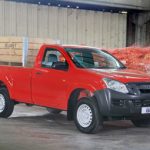On to the next phase

It’s taken a while, but the next phase of Johannesburg’s Rea Vaya bus rapid transit (BRT) system is ready to be opened. Here are the details.
August 2009 saw the first Rea Vaya bus enter service; with 64 currently running in Phase 1A on 25,5 km of routes in and around the Johannesburg CBD and to Thokoza Park in Soweto. Now, the next phase is ready for its buses to hit the streets.
Phase 1B – set to run on an 18,5 km trunk route from Soweto to the Johannesburg CBD passing through Noordegesig, New Canada, Pennyville, Bosmont, Coronationville, Newclare, Westbury, Westdene, Melville, Auckland Park and Parktown – will begin operation in October. This trunk route will be fed by feeder routes extending to surrounding areas – such as Soweto, Yeoville, Cresta, Roodepoort, Florida and Parktown – and will have the capacity to serve 40 000 passengers a day.
Passengers on these routes will be served by 134 buses, the chassis for which are being supplied by Mercedes-Benz’s Sandown Motor Holdings (see our full report in the June edition of FOCUS), with bodies being made by Marcopolo. According to Rea Vaya, a spin-off associated with the supply of these buses will be the creation of 300 new jobs and a further 40 over the next 12 years for their maintenance.
The announcement and final procurement of vehicles comes after parties affected by the implementation of the routes had been consulted and an agreement reached. Beginning in January, a Negotiation Framework Agreement (NFA) was signed by the City of Johannesburg and Putco and nine taxi associations affiliated to Top Six Taxi Organisation that would all be affected.
Unfortunately, FOCUS was not able to obtain any final details surrounding the agreement, but key concerns were: how to include operators and drivers, that would be removed from their routes and suffer a loss of income, by opening up empowerment and employment opportunities to them within Rea Vaya’s Phase 1B.
Chief executive of Top Six Taxi Management, Babubu Maharaj, said at the time: “If you’re not able to remove vehicles then you won’t be able to fill the buses or taxis, because now you will be competing with each other and none of the services can become viable.”
With Phase 1C planned for 2016 – extending the system north to Alexandra and Ivory Park along Johannesburg’s Louis Botha Avenue, and then across to Randburg through the Sandton and Rosebank CBDs – such delays will need to be avoided. The Phase 1C plan does, however, include the construction of three larger-scale, multi-modal interchanges at Sandton, Westgate and Pan Africa in Alexandra, to enable passengers to transfer between the Gautrain, Passenger Rail Agency of South Africa (PRASA) rail, Metrobus, mini-bus and metered taxi modes.
Other plans in the pipeline for the next year are the development of affordable and inclusive housing options along the Rea Vaya Phase 1B and 1C routes, such as at New Canada, Auckland Park, Marlboro and along roads such as Empire and Louis Botha. With the aim of making the Sandton CBD more inclusive and accessible to commuters within these areas. The Rea Vaya Phase 1C route along Louis Botha Avenue to Alexandra will also enable revitalisation and regeneration of areas like Hillbrow, Berea, Yeoville, Orange Grove, Alexandra, Marlboro and Wynberg.
Rea Vaya gets smart
As of the end of June, Rea Vaya passengers will no longer be issued paper tickets. From July 1, these will have been replaced by the system’s new Smartcard – a swipe-in swipe-out card for all Rea Vaya bus trips.
But the name Smartcard is not just some faint praise, the cards will also be able to be used for shopping, allowing Rea Vaya passengers to “travel smarter, faster and more securely” by avoiding the need to carry excessive amounts of cash. This, according to Rea Vaya’s marketing and communications director, Benny Makgoga, is a world first for Bus Rapid Transport (BRT) systems.
Commuters will be able to use their Smartcards to buy goods of up to R200 at any shop that accepts Absa MasterCards. Passengers can load funds up to R3 000 once a month at Absa ATMs, a Rea Vaya station kiosk or at approved vendors.
With the introduction of the Smartcard, Rea Vaya’s current three-tier fare system for complementary, feeder and trunk routes will be replaced by a “pay-as-you-go” type system. Prices for a distance of under five kilometres will cost R5,50, while the maximum fare, for a trip of 35 km or over, will be R14,20. Cards will be offered to passengers free of charge until the end of July, whereafter they will be sold for R20 each.
Commuters will need to register their card by simply filling in a form at the Rea Vaya station kiosks at Carlton Centre East, Art Gallery, Mavumbi, Diepkloof and Orlando Police Station or sending an SMS with their details to 33665 at a cost of R1,50; or registering online.
Published by
Focus on Transport
focusmagsa




